The MegaPenny Project
The original MegaPenny Project website disappeared. Since it was very cool, I had to find a copy. After finding it on the Internet Archives, I downloaded the pages and redesigned their interface.
The display on the right has tables at the bottom, listing things such as the value of the pennies, size of the pile, weight, and area (if laid flat). All weights and measurements are U.S. standards, not metric.
One Penny

One penny. Most people in North America have seen them and you probably have one in your pocket right now.
| value | 1¢ (one cent) |
| width | 0.75 inches (¾ of an inch) |
| height | 0.75 inches (¾ of an inch) |
| thickness | 0.0625 inches (1/16 th of an inch) |
| weight | 0.1 ounces (1/10 th of an ounce) |
| area | 0.5625 square inches |
Using this small metal disk, with a size and weight familiar to almost everyone, go to the next slide to see how it can grow.
Sixteen Pennies
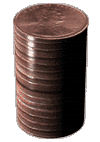
Every journey begins with a single step. So, to get to big numbers, you have to start small. Lay them out and you have an inch.
| value | 16¢ (sixteen cents) |
| width (side-by-side) | 12 inches (one foot) |
| height (stacked) | 1 inch |
| thickness | 0.0625 inches (1/16 th of an inch) |
| weight | 1.6 ounces |
| area (side-by-side) | 9 square inches |
One Thousand Pennies
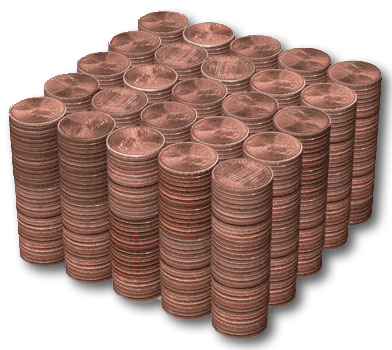
5 pennies wide x 5 pennies high x 40 pennies tall
A thousand pennies is only $10.00 worth of pennies, yet it weighs over six pounds. Now let’s put together a cubic foot made of these copper (3%) and zinc (97%) coins.
| value | $10.00 (Ten dollars and no cents) |
| width | 3¾ inches |
| height | 3¾ inches |
| thickness | 2½ inches |
| weight | 100 ounces (6¼ pounds) |
| height stacked | 62.4 inches (5.2 feet) |
| area (laid flat) | 562½ square inches (3.9 square feet) |
Fifty Thousand Pennies
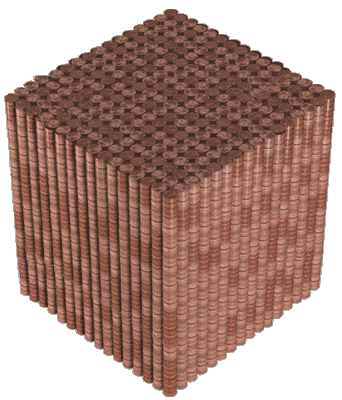
Forty-nine thousand one hundred and fifty-two Pennies
16 length x 16 width x 192 height — one cubic foot
Three hundred pounds of pennies. Remember the stack of 16 pennies? It was one inch tall. Well, take 12 of those and stack them and you’ll have a one-foot-tall stack. The cube above is made up of 256 of those one-foot stacks, making one cubic foot of pennies. Remember this cube, since it will be the building block for all upcoming penny-structures you see on these pages. Now let’s double it.
| value | $491.52 |
| width | 12 inches (two feet) |
| height | 12 inches (one foot) |
| thickness | 12 inches (one foot) |
| weight | 4,915.2 ounces (307.2 pounds) |
| height stacked | 3,072 inches (256 feet) |
| area (laid flat) | 192 square feet |
One Hundred Thousand Pennies
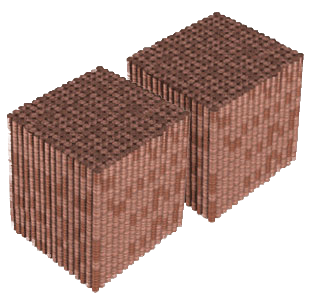
Ninety-eight thousand three hundred and four Pennies
Two cubic feet
Doubling our 50,000 pennies to 100,000, we now have two one-foot cubes. Given, this wasn’t a big jump, but now we’re going to start climbing the numerical ladder by powers of ten. Ever wonder what a million pennies would look like?
| value | $983.04 |
| width | 24 inches (two feet) |
| height | 12 inches (one foot) |
| thickness | 12 inches (one foot) |
| weight | 614.4 pounds |
| height stacked | 512 feet |
| area (laid flat) | 384 square feet |
One Million Pennies
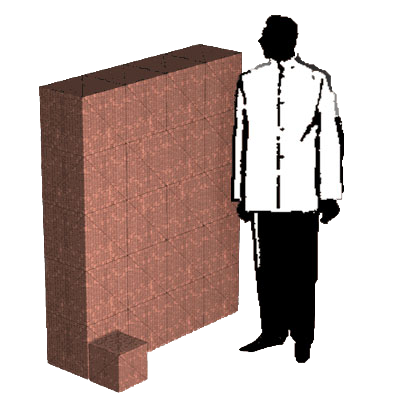
One million, three thousand, seven hundred and seventy-six Pennies
A wall five by four by one feet thick with a 9-inch cube stepstool
Say hello to our friend Graham. Now that the pennies have really begun to pile up, he’ll be standing in for scale. Graham is about 5 feet, 10 inches tall, and he weighs about 180 pounds or about 35 times less than the 1 million pennies stacked beside him. Next step, Ten million.
| value | $10,037.76 |
| width | Four feet |
| height | Five feet |
| thickness | 12 inches (one foot) |
| weight | 6273.6 pounds (3.14 tons) |
| height stacked | 5,228 feet (0.99 miles) |
| area (laid flat) | 3,921 square feet |
Ten Million Pennies
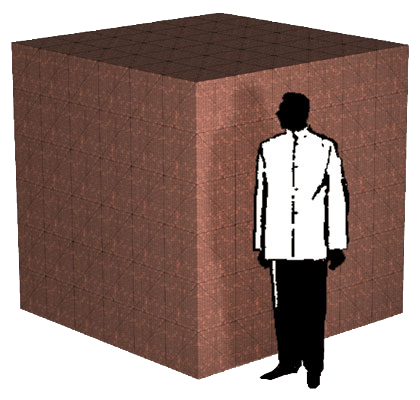
Ten million, seventeen thousand and twenty-four Pennies
A cube 6 x 6 x 6 feet
Ten Million cents. If you laid these all out flat, side-by-side, like a huge carpet of pennies, it would nearly cover one acre. The next slide has a look at 100,000,000 copper disks.
| value | $100,170.24 |
| width | Six feet |
| height | Six feet |
| thickness | Six feet |
| weight | 31.3 tons |
| height stacked | 9.88 miles |
| area (laid flat) | 39,129 square feet (0.9 acres) |
One Hundred Million Pennies
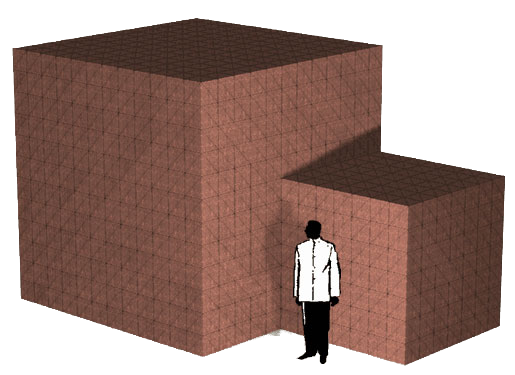
One hundred million, sixteen thousand, six hundred and forty Pennies
Two cubes, one 12x12x12 feet, the other 7x7x7 feet
Since these cubes are mostly dense metal, their weight is impressive. One hundred million pennies weighs over 300 tons. For comparison, the largest living animal, the Blue Whale, weighs less than 150 tons as an adult.
When you hear talk of “billion” of something (dollars, miles, people, etc), it’s hard to visualize. But up next, we have a visual for you — one billion pennies.
| value | $1,000,166.40 |
| width | 12 feet & 7 feet |
| height | 12 feet & 7 feet |
| thickness | 12 feet & 7 feet |
| weight | 312.5 tons |
| height stacked | 99 Miles |
| area (laid flat) | 390,690 square feet (9 acres) |
One Billion Pennies
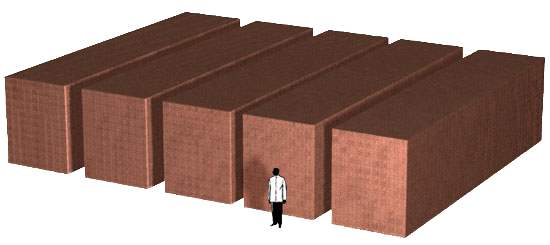
One billion, eighteen thousand, one hundred and seventy-six Pennies
Five school buses
Each of these blocks represents one 9x11x41 foot school bus – as seen below. If you were to stack all these pennies in a single pile, one atop the other, the stack would reach nearly one thousand miles high. For comparison, note that the Space Shuttle typically orbits only 225 miles above the Earth’s surface.

Only in North America and the general scientific community is this number (1,000,000,000) called a “billion.” Most European countries call this number either “one thousand million” or, in some cases, a “milliard.” Enough international confusion, let’s move on to ten billion.
| value | $10,000,181.76 |
| width | 45 feet |
| height | 11 feet |
| thickness | 41 feet |
| weight | 3,125 tons |
| height stacked | 987 Miles |
| area (laid flat) | 3,906,321 square feet (89.7 acres) |
Ten Billion Pennies
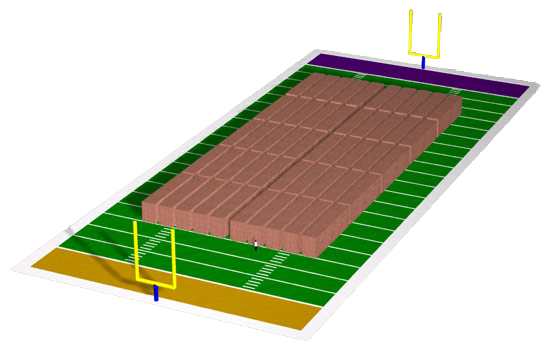
Ten billion, twenty-three thousand, five hundred and fifty-two Pennies
Fifty school buses
Current estimates place the world’s population at six billion people. The pile of pennies above would then be nearly enough for two pennies for every person on Earth. The U.S.Mint currently manufactures about this many pennies every year.
In the image above, Graham and his ten billion coins are now standing on a standard U.S. football field (360 x 160 feet) for further scale. Next up, the hundred-billion cube.
| value | $100,000,235.52 |
| width | 90 feet |
| height | 11 feet |
| thickness | 205 feet |
| weight | 31,250 tons |
| height stacked | 9,864 Miles |
| area (laid flat) | 897 acres |
One Hundred Billion Pennies
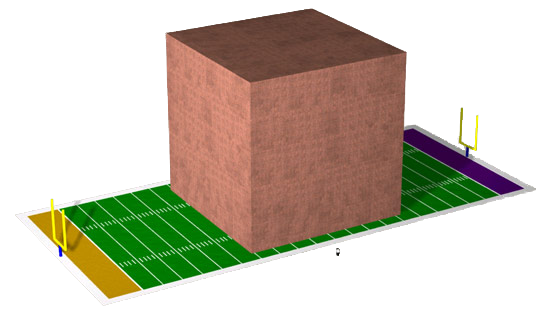
One hundred billion, seventeen million, six hundred fifty-nine thousand three hundred and thirty-six Pennies
One cube measuring 127 x 127 x 127 feet
If you took these hundred billion pennies and laid them out like a carpet, you could cover 14 square miles. Compare that to Manhattan Island, which measures 22 square miles.
The cube you see above is made up of over 4.1 million stacks of 24,330 pennies. Now, we are getting close to the limits of existing pennies. How many pennies do you think are currently in circulation?
| value | $1,000,176,593.36 |
| width | 126.72 feet |
| height | 126.72 feet |
| thickness | 126.72 feet |
| weight | 312,555.2 tons |
| height stacked | 98,660 Miles |
| area (laid flat) | 8,969 acres |
Two Hundred Billion Pennies

Two hundred billion, thirty-five million, three hundred eighteen thousand six hundred and seventy-two Pennies
Two cubes each measuring 127 x 127 x 127 feet
Current estimates by the U.S. Mint place the number of pennies in circulation at around 140 billion. Others have estimated as many as 200 billion currently circulating. Since the first penny was minted in 1787, until present-day, over 300 billion pennies have been minted in the United States. So that leaves about 100 billion pennies that have been retired by the Mint, lost down sewer drains, stored in jars, smashed by trains, or collected by numismatists in the past 200 years.
| value | $2,000,353,186.72 |
| width | 253.44 feet |
| height | 126.72 feet |
| thickness | 126.72 feet |
| weight | 625,110.4 tons |
| height stacked | 197,320 Miles |
| area (laid flat) | 17,938 acres |
Now that we have reached the limits of what actually exists, let’s move beyond, and into the Trillions.
One Trillion Pennies
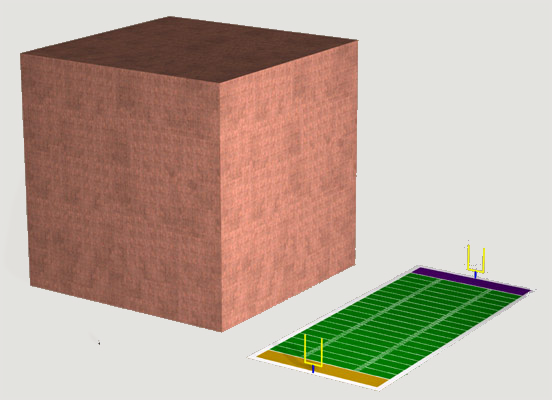
One trillion, sixteen thousand six hundred and forty Pennies
One cube measuring 273 x 273 x 273 feet
The same football field as the last two pages, set beside our new cube for scale. Notice our friend Graham, still barely visible as a speck at lower left.
| value | $10,000,000,166.40 |
| width | 273 feet |
| height | 273 feet |
| thickness | 273 feet |
| weight | 3,125,000 tons |
| height stacked | 986,426 Miles |
| area (laid flat) | 89,675.2 acres |
Let’s look at this new cube a little more closely to get a better idea of its size. →